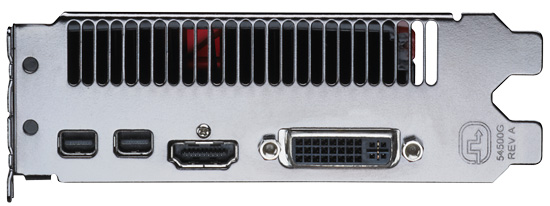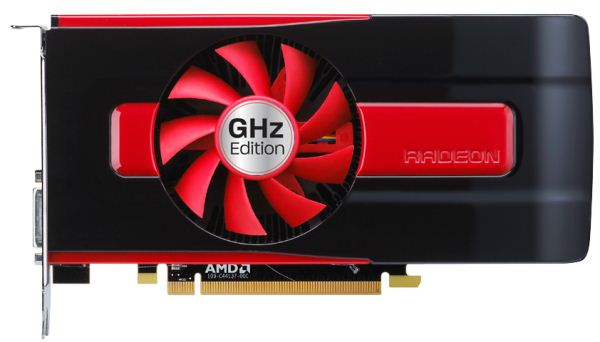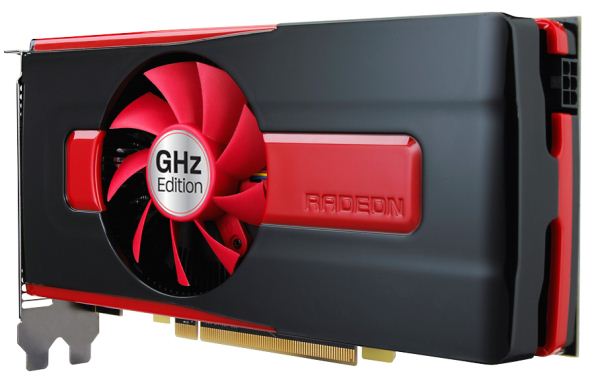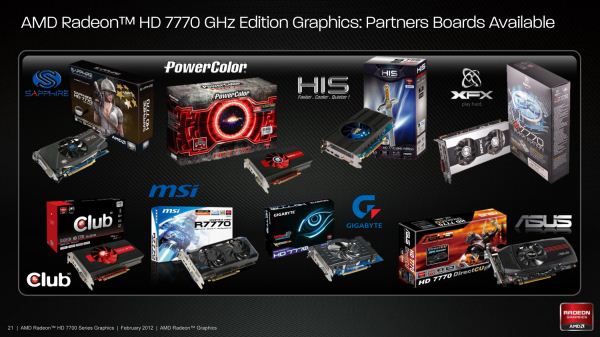AMD Radeon HD 7750 & Radeon HD 7770 GHz Edition Review: Evading The Price/Performance Curve
by Ryan Smith & Ganesh T S on February 15, 2012 12:01 AM EST- Posted in
- GPUs
- AMD
- HTPC
- GCN
- Radeon HD 7000
Meet the Radeon HD 7770 GHz Edition
The second card launching today is the Radeon HD 7770 GHz Edition. Compared to the 7750 it’s based on a fully enabled Cape Verde GPU and features a higher core clock of 1GHz, versus 800MHz on the 7750.
Starting as always with the cooler, for the reference 7770 AMD has gone with something that is best described as half of a blower. The shroud is completely enclosed on the sides, but due to the position of the fan the card exhausts hot air out of both the front and the rear of the card, which is something that’s common for dual-GPU cards such as the 6990 but atypical for a midrange video card. Heat transfer is provided by a basic black aluminum heatsink, while the fan is embedded in the middle of the heatsink.
As for the card itself, it’s effectively an extended version of the 7750. Like the 7750 the card is equipped with 4 256MB 5GHz Hynix GDDR5 RAM chips, along with some additional VRM circuitry to handle the higher 100W power limit for this board. External power is provided by a single 6pin PCIe power socket, while at the top of the card there is a single CrossFire connector. This is actually down from 2 connectors on the 5700 series, which comes as no great surprise as virtually no one ever used tri-CF with the 5700 series in the first place. Overall the card is 8.25” long with no notable shroud overhang, making it the same length as the 5770’s PCB.
Meanwhile for display connectivity AMD is using the same configuration as we’ve seen on the 7900 series: 1 DL-DVI port, 1 HDMI port, and 2 miniDP ports. Unlike the 7900 series AMD’s not requiring their partners to include any adaptors, so buyers with 2 DVI monitors will almost always be on their own. The presence of 2 miniDP ports means that the 7770 has quite a bit of flexibility in driving various displays, however as with the 7900 series if you want to drive more than 4 displays you will need a MST hub, the release of which is still some time off.

As for partner cards, as with the 7750 all of AMD’s partners are doing their own thing. No one will be using AMD’s reference cooler, though PowerColor in particular will be using a cooler similar to it. Everyone else will be using their own double-wide coolers, most of which will be open air as we typically see in this market segment. Like the 7900 series AMD is relying on the 7770 having some degree of overclockability, so there will be a number of factory overclocked cards taking advantage of this.
Finally, I wanted to quickly touch on the naming of the 7770. The official name of the 7770 is the Radeon HD 7770 GHz Edition; with the last bit being AMD’s latest marketing push. Starting with the 7770, AMD is going to be branding every card with a reference clock at or above 1GHz as a “GHz Edition” card to capitalize on the fact that they’ve hit 1GHz. Thus in spite of what the name implies there won’t be a 7770 non-GHz Edition card, as it’s a tagline rather than a true suffix necessary to differentiate cards.
With that said, while hitting 1GHz on a GPU is a notable accomplishment for AMD and should not be ignored, it’s not going to be particularly important in the grand scheme of things. The embarrassingly parallel nature of rendering means that GPU performance isn’t nearly as tied to clockspeeds as CPU performance is, as you can always lay down more functional units to improve performance. Clockspeeds do need to go up over time due to the limited parallelization of the command processor, but otherwise GPU performance has never been heavily dependent on clockspeeds.



















155 Comments
View All Comments
anactoraaron - Wednesday, February 15, 2012 - link
What happened there at 1920x1200 for the 6870? 23.2 fps seems a bit off to me. I get a solid 60 just about everywhere (occasional dips to ~50) at 1080.I am so glad I bought a 6870 ICEQ a month ago. Got the email today that I will be getting my rebate so your point about getting a 6870 for 159 AR is absolutely true. And the ICEQ edition I have is rocking a 1000/1150 oc all day long 32c idle 69c load via furmark 15 min run. Best part is it's much quieter than a reference card.
All of the 7xxx releases seem a bit lackluster to me.
Ryan Smith - Wednesday, February 15, 2012 - link
I go over this a bit in the commentary for that benchmark, but basically the 1GB cards are running out of memory in that benchmark. For reasons I've yet to determine, even though the 7700 series cards still only have 1GB they are handling the situation better than the 6800 and 5700.bazinga77 - Wednesday, February 15, 2012 - link
first thing that should be pointed out is that i believe that the 7700 series cards that launched today only have a 128 bit memory interface so no one should expect miracles especially at higher resolutions. the memory bandwidth on x700 cards and lower has always held them back a little, where as nvidia for instance on their 550ti uses a 192 bit memory interface. if this card used a higher bandwidth memory it would do better. also the 79xx series from amd upped the bandwidth from the 69xx series from 256 bit to 384 bit which is probably one of the reasons it was so impressive.well the gtx 460 is starting to disappear and amd discontinued the 6850 and 6870 two months ago so once they are gone they are gone. this is directly from amd. so i think this card fits in nicely and i expect once the 7850 launches that the price of this card will drop. i think that the 7770 almost being as fast as the 6850 isn't all that bad, especially because of how cool it runs and it seems like the factory oc cards close that gap even closer. considering how much power some of these cards took a couple of generations ago it seems like we are making progress. once the 7850 launches, which i believe happens next month, i think it will be the card to get, just as the 6850 was.
so all in all it seems like the 7770 will fit in nicely with a small price drop and and the discontinuation of some of the older amd and nvidia cards that has been happening, let alone taking into account the promotions we might see with rebates on these cards or bundled games etc.
lastly the 7750 seems like it will now be the best card on the market that doesn't require an external power connector and it will come in at only about $10 more than the current champ in that arena. so it looks like a nice card for the casual gamer or someone looking for an htpc card and it looks like the encoding features of the 77xx cards are pretty great.
chizow - Wednesday, February 15, 2012 - link
Like I said in the 7970 and 7950 review comments, the reality of the situation is only going to get worst as AMD reveals the rest of their 7-series product stack.Ryan I can tell you're doing your best not to be too hard on AMD but there comes a time we need to call a spade a spade. What AMD is doing here in terms of price and performance with the 7-series is easily the worst we've ever seen in the last decade from a new GPU architecture, especially considering they're also on a new process node.
If/when Nvidia pulls an RV770 on AMD, I really hope you and the rest of the media is up to the task the same way they were with the GTX 280. I don't think you were head GPU editor at that time but I'm sure you remember the backlash.
jjj - Wednesday, February 15, 2012 - link
So AMD either went stupid all of the sudden or they just can't produce enough cards yet and priced them to not sell.Either way,this is a mistake and they are only hurting their image (something they can't afford since Nvidia is still the stronger brand).Lets hope Nvidia wants market share and gives us something exciting soon.
stolid - Wednesday, February 15, 2012 - link
Arg. Might as well hang on to my 5770's. :/adonn78 - Wednesday, February 15, 2012 - link
And these cards are supossed to be an upgrade over the 6000 series how?Targon - Wednesday, February 15, 2012 - link
There is still a 7800 series set of cards that we have not seen yet. We saw the 7900 cards, and now the 7700 series. The comparisons here are 7700 vs. 6800 series, and that is ONE issue.Price vs. performance is the primary issue that I can see, and TIME will hopefully bring down the prices to a reasonable level. I also hope/expect that there are reasons for the prices that will be fixed quickly, so will reduce the prices. We shall see, but if NVIDIA is having problems, it may be that AMD is giving NVIDIA a chance to come back, and is saving their next big performance jump for that release.
chizow - Wednesday, February 15, 2012 - link
"Price vs. performance is the primary issue that I can see, and TIME will hopefully bring down the prices to a reasonable level."But that's exactly the problem, time hasn't brought price down to a reasonable level because we've already had 14+ months of this performance level at the same or better prices. AMD's pricing does nothing to shift the price performance metric and if anything, they are actually falling behind the curve a bit as you can get "old" parts that perform the same or better than these "new" ones at much lower prices.
The 7800 series will only emphasize this point further with similar performance relative to the 6900 series, but at much worst prices. But that's the trickle down effect of pricing a new "high-end" flagship part that's only 15-25% faster than the last-gen at a 10% price hike. There just isn't much value derived as you go further down the ladder.
ET - Wednesday, February 15, 2012 - link
This is disappointing, although I agree that the 7750 does have a place due to its low power. Let's see what NVIDIA will offer.The only ray of sunshine is that as always with a new architecture it takes a while for the drivers to take full advantage of the hardware, so it's possible to see performance improvements of tens of percents over time. Let's hope that's the case here.